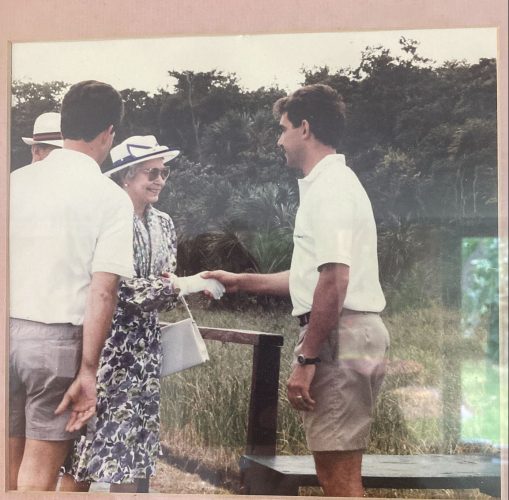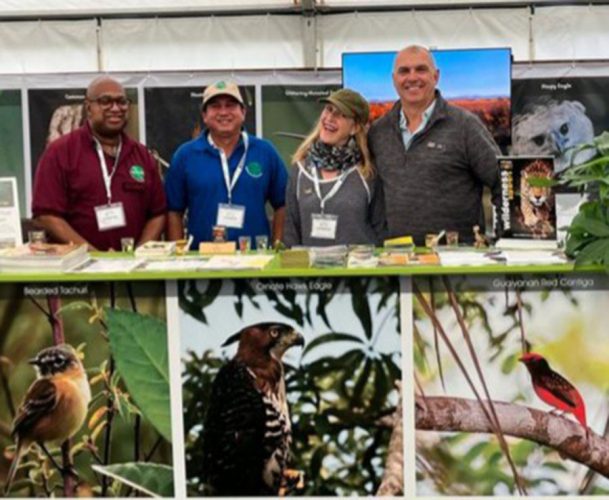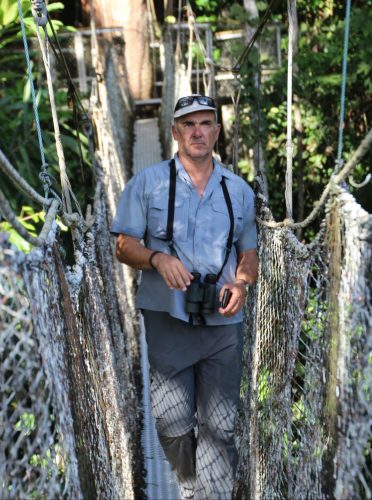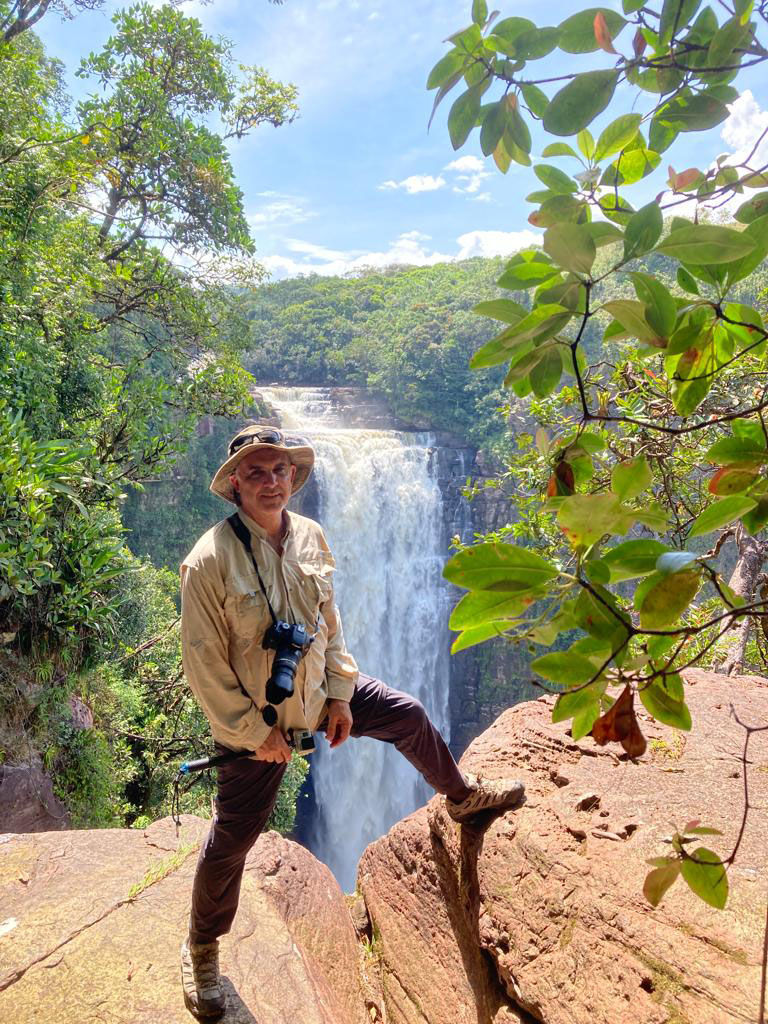After 33 years in the local tourism industry that he helped to build, Tony Thorne, an Australian-born Guyanese tour operator and managing director of Wilderness Explorers, would like to see more lodges opened across the hinterland to boost the growing demand for Guyana’s unique sustainable tourism products as visitor arrivals increase with more airlifts becoming available.
“Hotels are being built in Georgetown but the demand for lodges across rural areas is picking up. We need more people investing in lodges and accommodation in the interior. Many visitors come primarily to travel to the interior. American Airlines and British Airways coming into Guyana because of oil and gas, has created opportunities for tourism,” Thorne told Stabroek Weekend in a recent interview from Melbourne, Australia.

Born and bred in Ballarat, Victoria, Thorne first worked as a plumber. Wanting adventure, he joined the Australian Army and spent much of his time stationed in Malaysia. When he left the army he wanted to travel the world. “With a backpack, myself and a friend, Gavin O’Brien, took a one-way ticket each, to England just for an adventure,” he recalled.
In England, Thorne enlisted in the British territorial army. As part of the selection process, he had to do a weekend of endurance training where he was identified as suitable for Operation Raleigh expeditions. He applied to Operation Raleigh, was accepted and offered the position of project leader for young people between the ages of 17 and 25 with its expedition to Guyana in June, 1988.
“I didn’t know where Guyana was but not knowing was exotic enough for me,” he said.
Thorne spent four months leading expeditions on the Essequibo Coast, Tiger Island, Bartica and Orealla on the Corentyne River.

“The rural, untouched, remote, wild areas of Guyana appealed to me. It was a challenge at 25 years to be in charge of a group going into places I didn’t know. I spent a couple of months at Orealla, trying to understand the Indigenous community and how it operated. If I hadn’t taken that opportunity, I might have never gotten involved in tourism, or, in Guyana at all,” he noted.
Thorne did another expedition with Operation Raleigh in Queensland, Aus-tralia. “My plan was to stay in Queensland and get involved in the tourism industry,” he said. “However, the pilots went on strike for six months and it impacted negatively on the tourism industry.”
In 1990, he went to Newcastle, New South Wales and decided to do some tourism studies. The only course was a travel agent’s course which he did. His tutor, he said, while covering South America, told students that they need not know anything about Guyana, Suriname and French Guiana.
“That has been a driving force for me to get Guyana on the map. Of course oil and gas will do that job faster than tourism but I would like, if that course is still taught today, that they talk about Guyana, its wildlife, its culture, Kaieteur Falls and things like that,” he said. When speaking about Guyana, he noted, people assume it is somewhere in Africa [and] “That has been a challenge.”

In 1991, he took a one-way ticket to Santiago, Chile with his girlfriend at the time and another friend. They then went to Brazil for the Rio Carnival and on to Guyana for the Australia-West Indies test match. “The three of us were among a small group of about 13 Australian supporters at the test match. It was a wonderful experience,” he recalled.
In Georgetown, he contacted Paul Stephenson, then general manager of the Pegasus Hotel who he had met on his trip with Operation Raleigh and who was looking for a manager of Timberhead Resort. Stephenson offered him the job for six months.
“My girlfriend said, ‘You don’t know anything about tourism. You can’t do that’. I said, ‘You shouldn’t tell me I cannot do something’,” he said. He took the job and broke up with his girlfriend over that. Six months turned into three years.
Thorne packaged the Pegasus Hotel, Timberhead and Shanklands on the Essequibo River as one to sell rooms and as such he became a tour operator in the process. When he started he knew nothing about tourism. “Not many people in Guyana were involved in tourism. I learnt on the job. I had to make things work to develop the business,” he said.
Meanwhile, his friend Gavin O’Brien, who he went to primary and high schools with, had remained in the UK.
“At the end of 1991, Gavin decided to return to Australia. I invited him to visit me in Guyana. He intended to stay for two weeks. He worked with me at Timberhead and when I left he became the manager. He married a Guyanese and he has been working in Guyana ever since. A manager at Cara Lodge, he has been there since the mid-1990s. Gavin’s wife Teri was Wilderness Explorers’ general manager for over 22 years,” Thorne related.
THAG
In 1991, Thorne chaired the steering committee to get the then Tourism Asso-ciation of Guyana (TAG), established.
“I wrote the articles of the association. In December 1991, at our first annual general meeting, I was elected the first president of TAG which later became the Guyana Tourism and Hospitality Association of Guyana (THAG).”
Thorne was an executive member of THAG for ten years.
Tourism at the time involved a few other people who offered trips to Kaieteur Falls and on the Essequibo River mainly for people doing business in Guyana and who might have wanted to do something on a weekend.
“There were hardly any lodges at the time. There was Timberhead, Shanklands and later Emerald Towers. Then Karanambu got involved,” he said.
The very first trade show Thorne went to was to the World Travel Market in London. He asked the airline LIAT to share their booth.
“We made posters that were handwritten with photographs stuck on them like a school project. I still laugh at how unprepared we were. When we were asked things like what our net rent rates were like, we had no idea what that meant. Those first couple of years I would be awake at nights with a notepad writing down ideas and questions because I was learning and I had to find ways to get answers. As the first tour operator trying to sell Guyana as a destination, it was unbelievable and incredibly exciting when we finally had a footprint out there,” he said.
“At the time President [Desmond] Hoyte’s government was offering tax free incentives to boost tourism. Timberhead had brought in boats and vehicles.”
After three years of managing Timberhead, Thorne decided to become a tour operator. “My former wife, Trudy and I, developed Wilderness Explorers in late 1994.”
They targeted clients for the ‘long haul, long stay’ from European markets and not those who were in Guyana on business.
“Soon we were competing with everyone else for day trips to Kaieteur Falls and the Essequibo River but our aim was to develop a package. That meant working with Shanklands, Karanambu, Rock View Lodge among others to create packages for the market.”
Initially it was just Thorne in the office and field. “Then we hired a tour guide and we slowly built up over the years,” he added.
Over the years they were negatively impacted by various things including the cyanide spill in the Essequibo River from the Omai Gold Mines in 1997, the 9/11 tragedy, bird flu and more recently Covid-19.
Community tourism
In 1999, Wilderness Explorers established a relationship with Surama to work in community tourism. “I guess we were the first business to help them to develop their product,” he said.
Thorne, who had met Sydney Allicock of Surama through Colin Edwards of Rock View Lodge, had received Canadian grant funding to conduct tourism/visitors training and Allicock took part in the training. He encouraged Surama to get involved in tourism.
“There was a lot of scepticism. In the end, Sydney convinced them to give it a try. We then signed a memorandum of understanding with the community on our respective roles. We assisted in training, understanding pricing and taking their product to the market. Twenty-three years later, tourism has become an integral part of Surama, accounting for about 60 per cent of the village economy, either directly or indirectly. Surama’s tourism today is a model for community tourism and how it can benefit Indigenous communities,” he said.
Locally, tourism is largely positive for communities, Thorne said, not just from a financial perspective but for cultural and professional development. “Surama for example has a cultural group in which they teach young people their traditional songs and dances. They have developed some modern songs and dances that tell tourism stories. You are seeing an evolution of their culture.”
Community tourism, an important part of his business, Thorne said, “is one of the pillars of our tourism in Guyana.”
Currently, Wilderness Explorers is working with Paruima to market its product. “Paruima is a wonderful community with excellent guides. We’ve helped them to develop a trek to two amazing waterfalls, Kamarang and Uchi. Maybe less than a 100 people, foreigners and locals, would have gone to these waterfalls. Uchi Falls is a bit shorter than Kaieteur Falls, yet it isn’t well known.”
Thorne has also worked with Dadanawa as well as Wowetta to develop their community rock trails. “We also send a lot of trips to Surama, Rewa and Caiman House in Yupukari where there is a circuit of lodges which has global award winning products. We did training with Warapoka but we take less people to Warapoka because out in the North West (Region One) there is a shortage of lodges.
“We aim to work in other locations like North West Guyana where we’re looking to develop some new products and create new circuits in 2024.”
A restricting factor with the lodges in the interior is lack of exposure, Thorne said. “Someone who lives in a community in the middle of the rainforest, probably never had the opportunity to stay in a hotel or a lodge. So they operate in a bit of a bubble. We are all bidding for the same customers. We have to understand what the others are doing and why people are visiting them.”
The Guyana Highlands Trek, which covers Georgetown, the rainforests, the Rupununi Savannahs, Kaieteur Falls and community tourism is one of the outstanding tours that stands out for Wilderness Explorers.
“Over the years we have received awards from National Geographic travel magazine for two of the Guyana nature experiences. Ten years ago we got recognition from them for that particular tour. We run the tour eight to ten times a year.”
In 2003, Thorne also received the Ernst and Young Entrepreneur of the year award for tourism in the Caribbean. He was the second inductee into THAG’s Hall of Fame. He has also won several other awards throughout the years.
Around 2000, Wilderness Explorers started to look at multiple destinations. “We added Suriname and French Guiana. People in Europe want to visit other places. With flights coming through the Caribbean, we now sell the Caribbean in conjunction with Guyana to complement its product. With British Airways flights coming via St Lucia, offering a Guyana and St Lucia product, makes sense.”
Guyana represents about 85 percent of Wilderness Explorers’ business.
“We evolved from just being a tour operator into a destination management company doing destination marketing, training and product development.”
Every year Thorne takes Wilderness Explorers to trade shows including the ITB Berlin and the World Travel Market.
“We contribute to Guyana being the destination to travel to in 2023 and in 2024. We work closely with the Guyana Tourism Authority and the industry as a whole. We bring down a lot of travel journalists, including a group last month. The Times contacted us recently and Atta Rainforest Lodge which sits in the Iwokrama international reserve, which we manage, is one of the twelve lodges The Times named to visit next year,” he said.
Wilderness Explorers partners with Iwokrama which also operates the Iwokrama River Lodge, and Surama through a subsidiary company, Community and Tourism Services. “We operated a fam trip for British Airways in April this year. Six stories have been published in the UK about that.”
Wilderness Explorers has representatives in the UK, Germany, Spain and in Sweden for the Nordic regions in addition to providing information on its website and on social media to promote Guyana’s image. “Because of our maturity, we’re able to do the marketing that smaller companies don’t have the capacity to do.”
Throughout the years, Wilderness Explorers has done its share of corporate social responsibility in an ad hoc manner mainly with communities it has partnered with. This year it has registered an organisation, the Kayap Wilderness Foundation to execute its CSR. “A lot of international tour companies want to provide funding for sustainable projects in communities that need assistance. We can help.”
Filming
Wilderness Explorers has worked with the foreign film industry including National Geographic, the BBC and Discovery Channel among others.
In 2021 during the Covid-19 pandemic, Wilderness Explorers had two shoots with National Geographic. One documentary, The Last Tepui, was aired in 2021.
“The Tepui next to Mount Roraima, as far as we knew, hadn’t been climbed before. We went with a group of world class climbers including Alex Honnold, considered the world’s number one climber. Bruce Means, an 80-year-old biologist accompanied us on that one-month expedition. Seventy-three people from Phillipai supported us. It took a week’s trek to get to the bottom of the mountain, then climbing up and coming down,” he related.
Later in the year National Geographic produced a series, Primal Survivor on Guyana. They were filming in Guinea but because of Covid-19 they switched to Guyana at short notice.
“We helped them with their storyline and came up with ideas. We were testing for Covid-19 ahead of shooting and we often found incidences in communities,” he said.
Wilderness Explorers did three fishing shows with British television presenter Jeremy Wade on general wildlife, adventure and culture. “We get to be involved in some really meaningful productions that help to promote Guyana.”
In 2022 Wilderness Explorers hosted an event at a cinema in Bristol, England to show production companies what Guyana has to offer and to consider Guyana when they are looking for locations in which to film.






